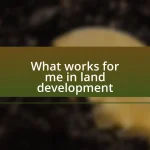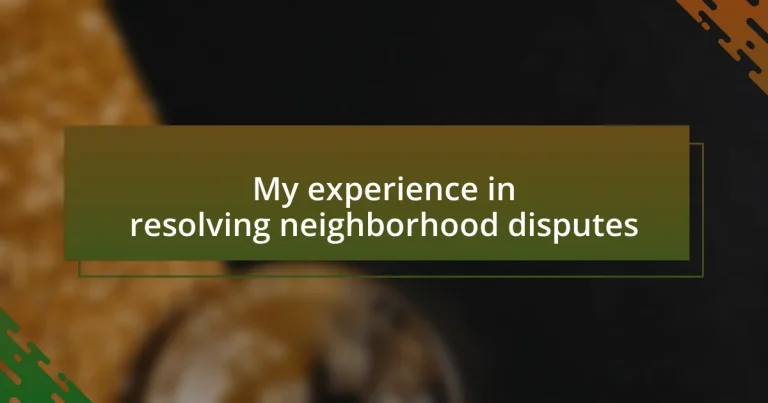Key takeaways:
- Neighborhood disputes often arise from misunderstandings, highlighting the importance of empathy and open communication.
- Common causes include property maintenance, parking issues, and children’s activities, which can lead to conflicts reflecting differing perspectives.
- Effective communication techniques, such as active listening and using “I” statements, can help resolve disputes and foster stronger community ties.
- Long-term harmony can be achieved through shared community activities and celebrating progress, reinforcing positive relationships among neighbors.
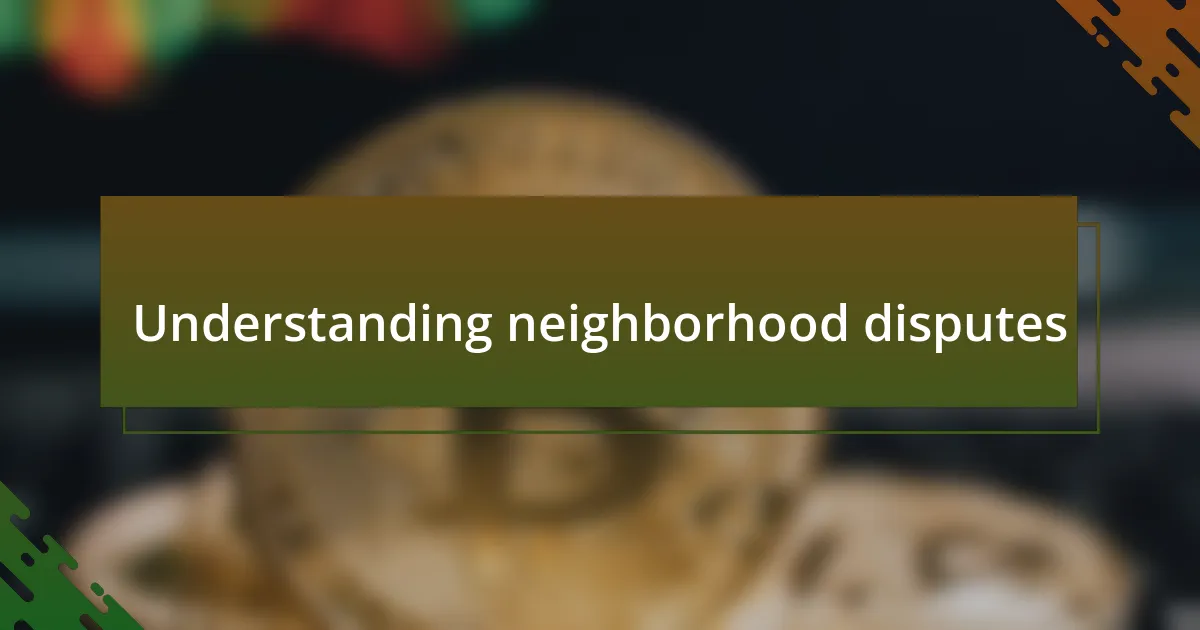
Understanding neighborhood disputes
Neighborhood disputes often arise from misunderstandings or differing expectations between residents. I remember a time when a disagreement about property boundaries caused tension between my neighbor and me. It made me wonder—how often do we assume the worst instead of trying to understand each other’s viewpoints?
Many disputes can stem from noise levels or shared spaces. I once heard loud music blaring from a neighbor’s house late into the night. It was frustrating, but it led me to reflect on how easy it is to overlook the challenges others might be facing. Do we ever consider that people have different lifestyles that shape their actions?
Ultimately, neighborhood disputes can be emotionally charged, as they strike at the heart of our daily lives and community interactions. I once felt a knot in my stomach as I approached a neighbor about a lawn issue, fearing conflict. This experience taught me that open communication and empathy could diffuse even the most tense situations. Isn’t it fascinating how vulnerability can pave the way to resolution?
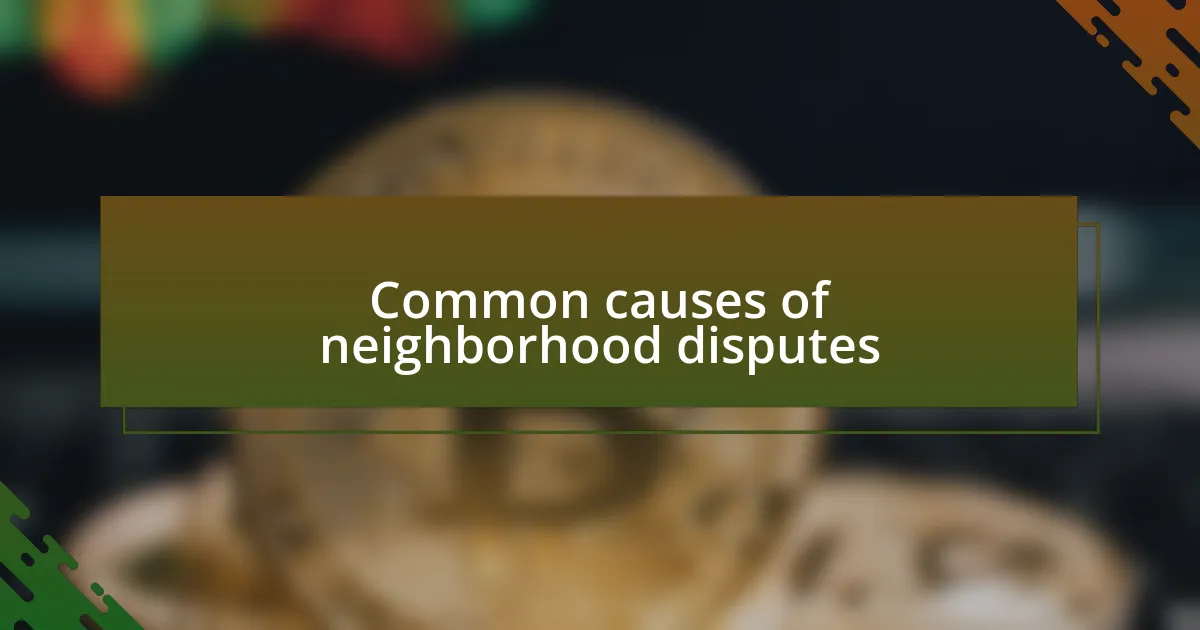
Common causes of neighborhood disputes
Common causes of neighborhood disputes can vary widely, but there are a few recurring themes. One major factor is property maintenance. I recall a neighbor whose overgrown yard became a constant point of irritation for me and others in the community. It made me think about how our homes reflect our values, and what one person sees as “lived-in,” another may view as “neglected.”
Another common cause is the ever-sensitive topic of parking. I have angry discussions in my own neighborhood about where residents could park their cars without infringing on each other’s space. This issue can spark debates that escalate quickly, transforming a simple disagreement into a full-blown neighborhood feud. It’s fascinating how something as mundane as parking can evoke such strong feelings, primarily when community spaces are limited.
Lastly, children’s activities can also lead to disputes. I remember the unease when kids played soccer in the cul-de-sac, leading to complaints about noise and potential damage. This scenario makes me wonder if we’ve lost sight of the joy of neighborhood youth. Each experience reminds us that what stirs contention in our neighborhoods often boils down to perspective and communication.
| Cause | Example |
|---|---|
| Property maintenance | Overgrown yards can lead to feelings of neglect |
| Parking | Disagreements about public parking spaces |
| Children’s activities | Noisy play can disturb neighboring households |
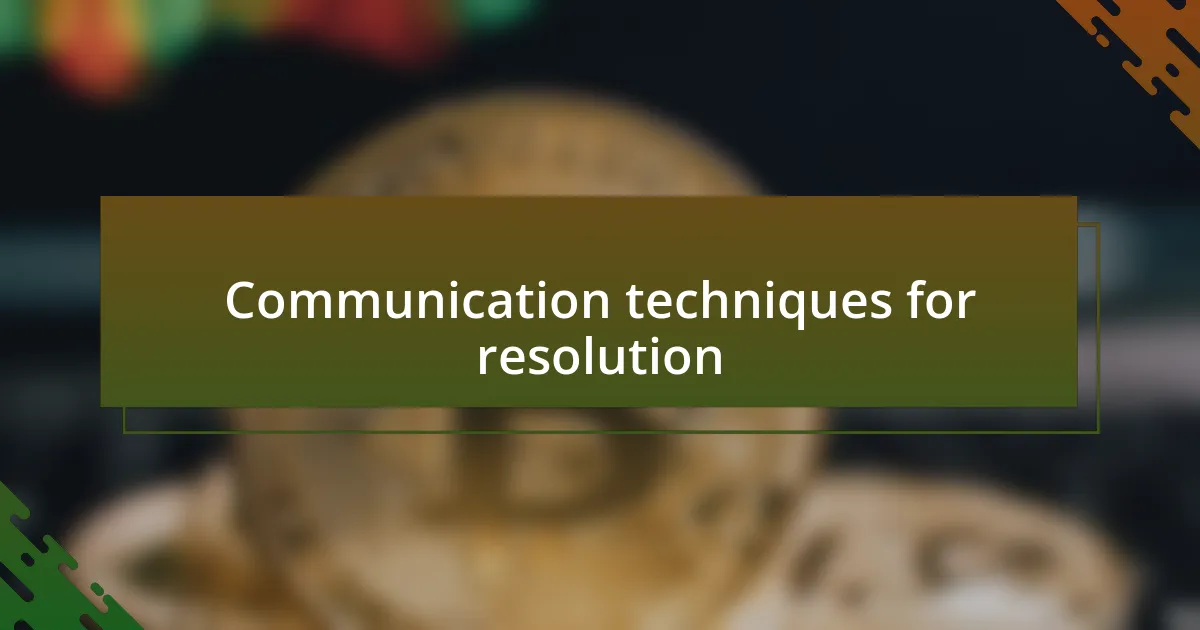
Communication techniques for resolution
Communication is often the key to resolving neighborhood disputes effectively. I’ve learned that active listening can transform a heated discussion into a productive dialogue. When I take the time to genuinely hear my neighbors’ concerns, I notice their frustration diminishes significantly. It’s about creating a space where all parties feel respected and understood.
Here are some techniques I find useful for fostering open communication:
– Active Listening: Show that you value what the other person is saying by paraphrasing their points. This not only confirms understanding but also demonstrates care.
– Open-Ended Questions: Encourage a more extensive conversation by asking questions that require more than a yes or no answer. For instance, “How can we find a solution that works for both of us?”
– Calm Tone: Maintaining a non-confrontational tone can set the atmosphere. I remember a time when I approached a neighbor with a concern in a calm voice, and it instantly defused the tension.
– Use of “I” Statements: Instead of saying, “You always…” try, “I feel upset when…” This technique reduces defensiveness and keeps the focus on your feelings.
– Body Language: Sometimes, it’s not just about what we say but how we say it. I’ve noticed that open body language, like facing the person and nodding, encourages a more positive interaction.
In my experience, employing these techniques not only resolves disputes but also builds stronger relationships within the neighborhood.
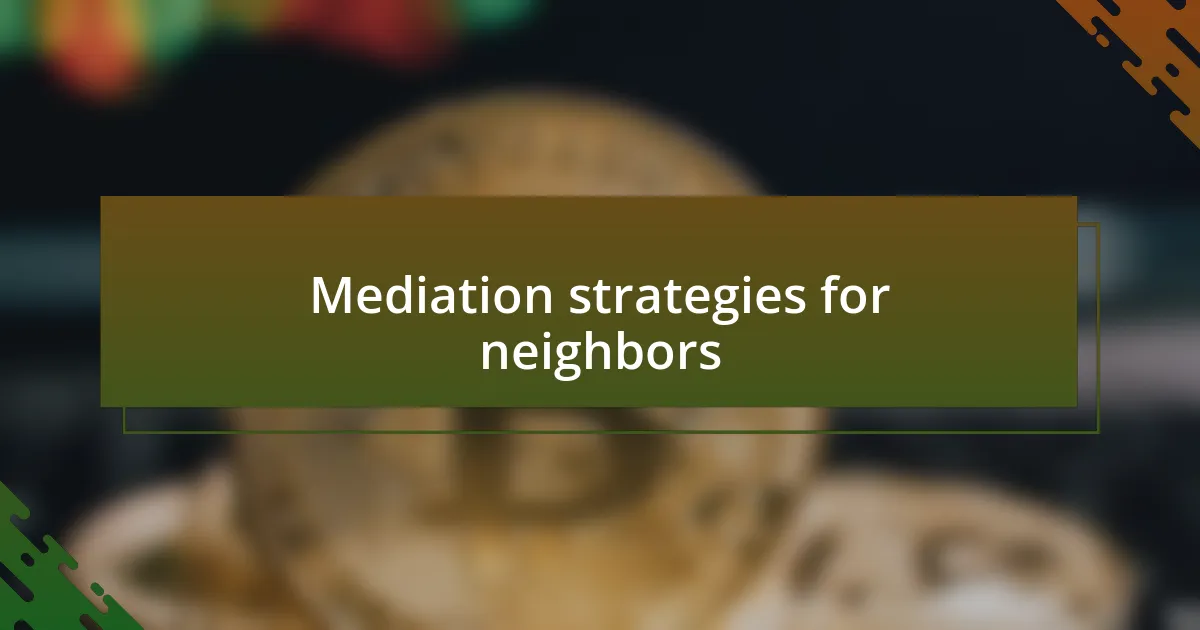
Mediation strategies for neighbors
Mediation strategies can be incredibly effective in resolving neighborhood disputes. One approach I’ve found valuable is to bring in a neutral third party, like a local community leader or a trusted friend. When I faced a disagreement over property lines, having someone objective helped both sides express their concerns without feeling attacked, leading to a more amicable resolution.
Another strategy is to establish a mediation framework that includes setting ground rules. For example, I remember organizing a small meeting with my neighbors where we agreed to speak one at a time and avoid interrupting each other. This simple structure made everyone feel safe to share their viewpoints, helping to alleviate tension and promote understanding.
Finding common ground can also be a game-changer. During a dispute about noise levels, I suggested we all agree on “quiet hours.” This compromise not only addressed the immediate issue but also fostered a sense of community, as we worked together to create a peaceful environment. Isn’t it amazing how a little collaboration can pave the way to harmony?
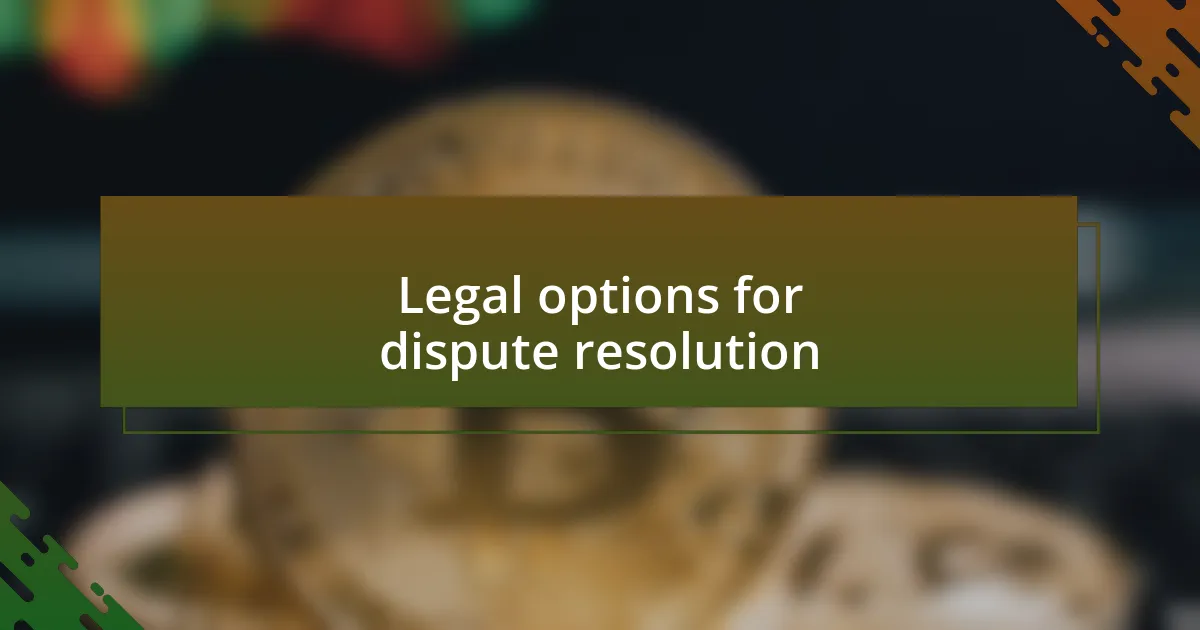
Legal options for dispute resolution
When disputes escalate beyond mediation, legal options become necessary. I recall a situation where a neighbor’s fence encroached on my property. Initially, I hesitated to involve legal channels, fearing it would strain our relationship further. However, after considering my rights, I consulted a local attorney who guided me through the process of filing a formal complaint. Understanding the law empowered me, transforming my fear into a strategic approach.
In cases that require more formal intervention, I’ve seen people explore small claims court as an option. I remember a neighbor who had ongoing issues with another over a tree that frequently dropped debris into their yard. Instead of letting emotions dictate the situation, they decided to file a claim. While it felt daunting at first, presenting their case clearly in front of a judge ultimately brought clarity and led to a resolution everyone could respect. Isn’t it fascinating how the legal system can sometimes restore peace that seemed lost?
Arbitration is another legal route that some might overlook. I once recommended it to a close friend facing a noisy tenant. They chose arbitration, where an independent arbitrator made a binding decision. This approach not only saved them time but also provided a definitive end to the dispute, allowing everyone to move on. When navigating tricky situations, knowing these legal options can truly make a difference in achieving a fair outcome.
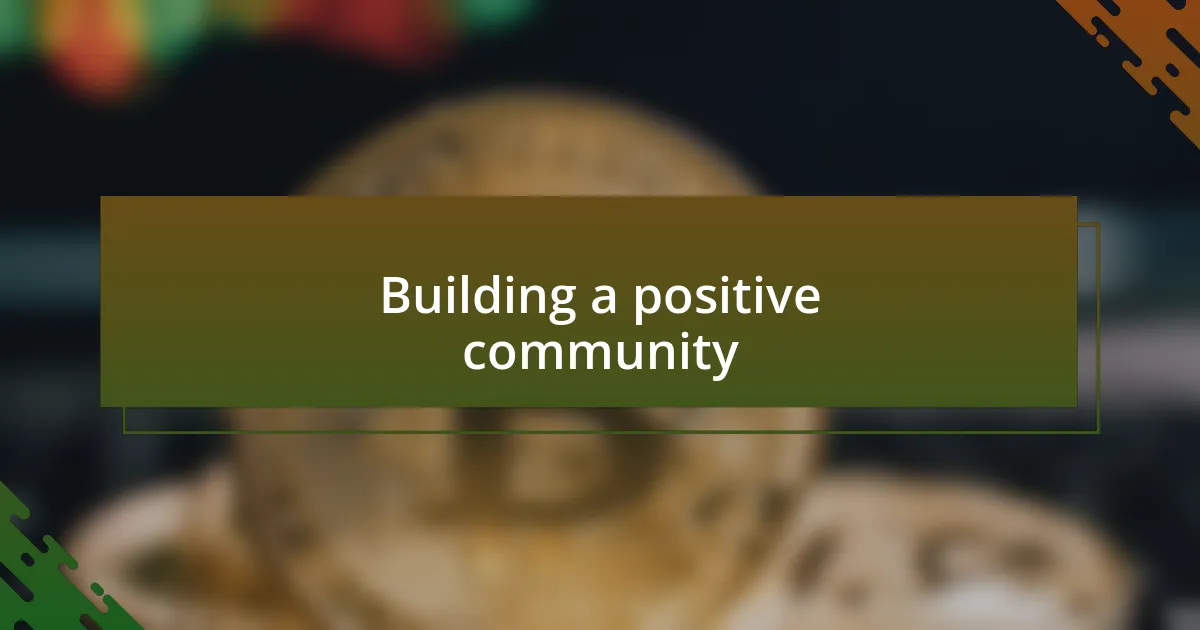
Building a positive community
Building a positive community is essential for fostering strong relationships among neighbors. I once organized a block party in my neighborhood, inviting everyone to contribute a dish and share stories. The laughter and conversations that bloomed that day not only broke down barriers but also created bonds that last even today. Isn’t it amazing how simple gatherings can actually pave the way for deeper connection and understanding?
Creating a welcoming environment involves actively listening to each other’s concerns. I remember a time when a neighbor started a community book club. Initially, not many participated, but as I engaged with a few others and shared our thoughts, more residents began to join. Realizing that everyone had a voice and a unique perspective was key to enhancing our community spirit. How often do we overlook the power of simply listening to one another?
Moreover, establishing regular communication can make a world of difference. In my own experience, I initiated a monthly meeting where neighbors could voice their worries and brainstorm solutions together. There was something reassuring in that shared space; frustrations began to transform into collaborative efforts. Have you ever considered how a simple conversation can reshape the atmosphere of an entire neighborhood? It truly can, and I’ve seen it firsthand.
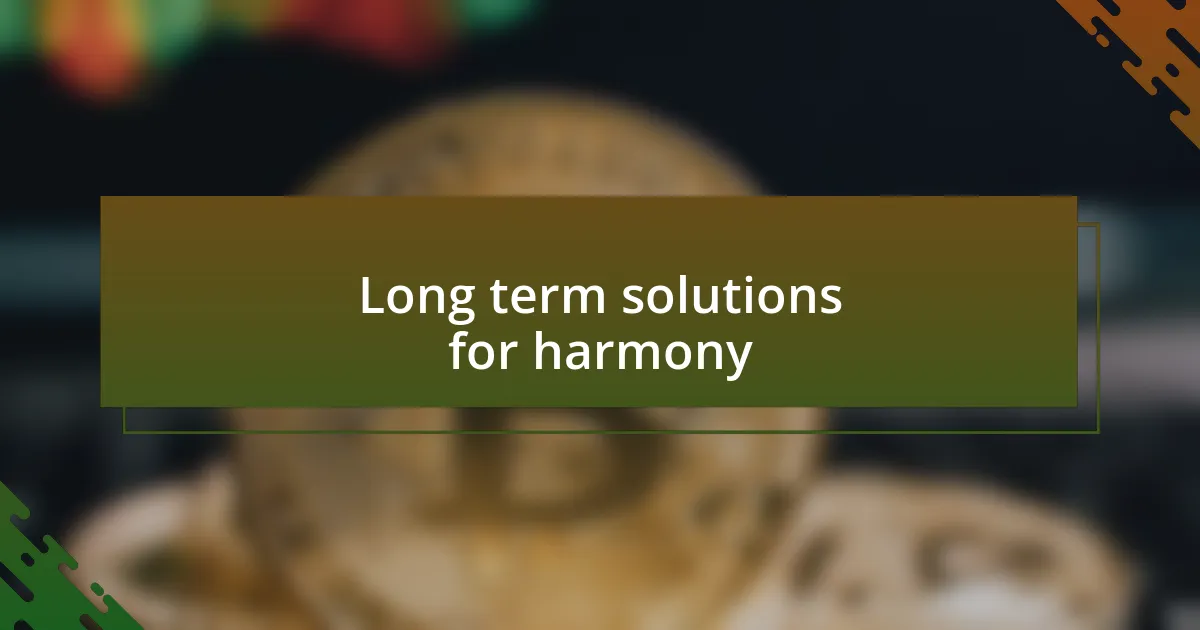
Long term solutions for harmony
Finding long-term solutions for harmony is often about establishing shared values and priorities. I recall a time when our neighborhood faced a disagreement over a local park’s use. After some heated discussions, I proposed we all take a walk in the park together to discuss our views. It was eye-opening to see how the scenery and fresh air transformed our conversation from contentious to collaborative. Have you ever noticed how stepping away from our usual spaces can shift our perspective?
Another effective approach is initiating community projects that require teamwork, like a neighborhood garden. I remember the joy when a few families joined together to plant flowers and vegetables. We each learned not just about gardening, but also about each other, building mutual respect and camaraderie. Isn’t it fascinating how shared responsibilities can weave a stronger fabric of community?
Lastly, I believe it’s essential to celebrate the progress made along the way. After resolving our park disputes, we organized a small festival to mark the renewal of our community space. The collective pride and the joy that resonated from that event made a lasting impression. How often do we take the time to acknowledge our victories, big or small? In my experience, celebrating together can reinforce positive behavior and strengthen relationships.


